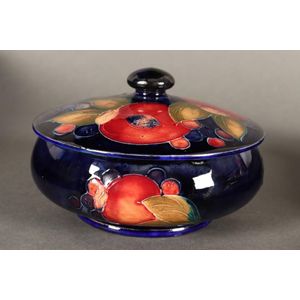Moorcroft Pomegranate Jar and Cover
William Moorcroft 'Pomegranate' jar and cover, c.1928-49, the body of squat circular form with a slightly domed cover and finial, decorated with pomegranates and berries on a rich Royal Blue ground, with impressed signature, 'Potter to H.M the Queen' and 'made in England' mark, height 9 cm and diameter 15 cm
You must be a subscriber, and be logged in to view price and dealer details.
Subscribe Now to view actual auction price for this item
When you subscribe, you have the option of setting the currency in which to display prices to $Au, $US, $NZ or Stg.
This item has been sold, and the description, image and price are for reference purposes only.
- Dating English Ceramics - Excellent detailed reference books such as Godden's Encyclopaedia of British Pottery and Porcelain Marks will help to identify and date specific manufacturer's marks.
However, there are a few simple guidelines which may also help.
The inclusion of the word 'England' on an item ensured compliance with the American McKinley Tariff Act 1891, which was important for British exporters. An item so marked would have been made after 1891.
In 1921 the act was revised to require the phrase 'Made in' followed by the country. So if an item is marked 'Made in England', it is generally considered to be made after that date, although some manufacturers were using this phrase pior to the act being changed.
The use of the word 'Ltd' of 'Limited' after a company's name indicates a date after 1860, though with ceramic manufacturers this did not become general practice until the 1880's. - Finial - An architectural decoration, found on the upper parts of of an object. On furniture they are usually found on pediments, canopies and shelf supports. On smaller ceramic or silver items, such as spoons, they may decorate the top of the item itself, or the lid or cover where they provide a useful handle for removal.
Finials have a variety of shapes and forms. They may be urn-shaped, baluster shaped round or spiral, but usually taper into an upper point. Many real life shapes may also be used as finials, such as pineapples, berries, pinecones, buds, lotus and acorns. Sometimes animals such as a lion are depicted, or fish and dolphins.
This item has been included into following indexes:
